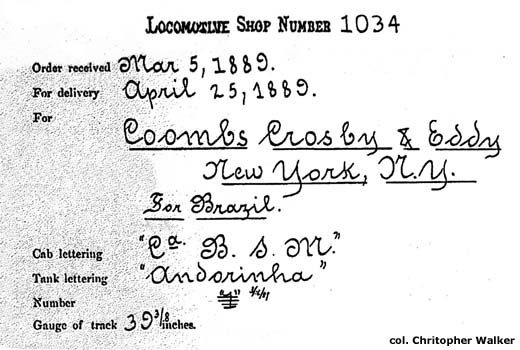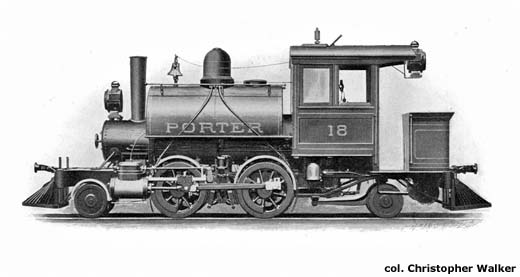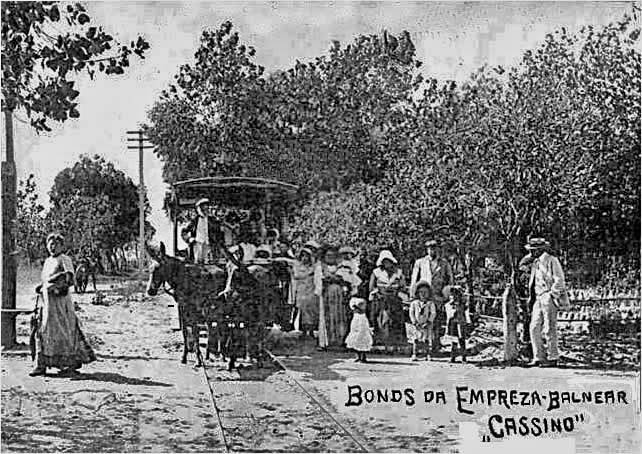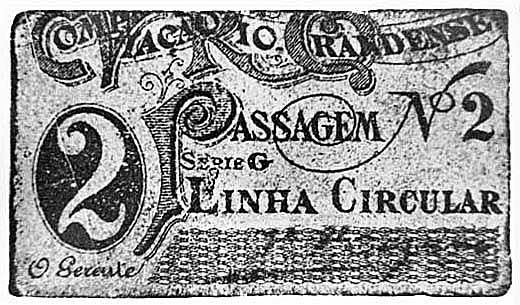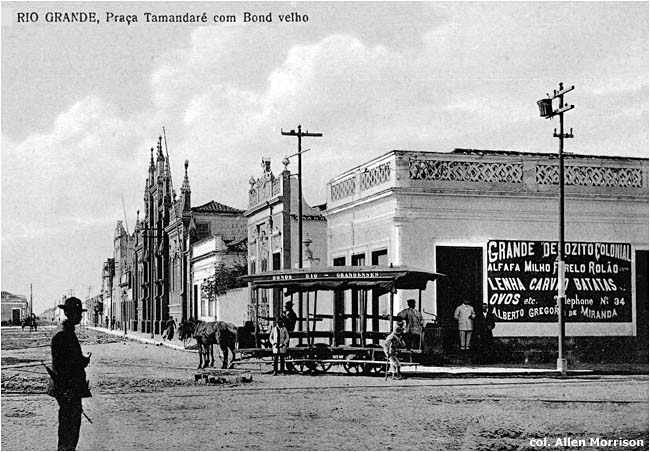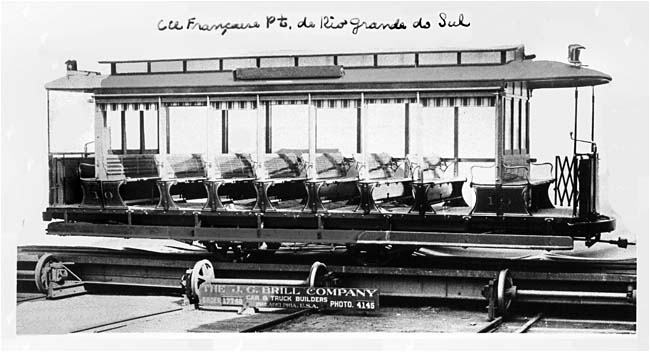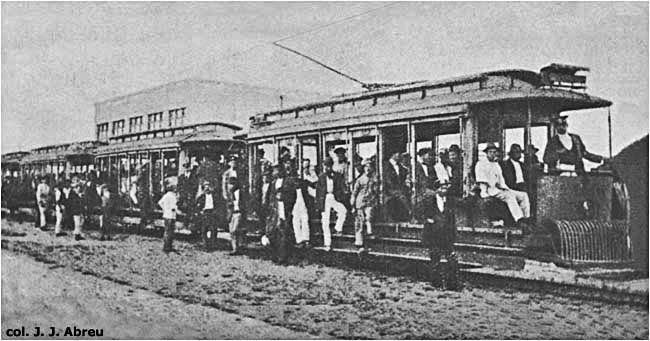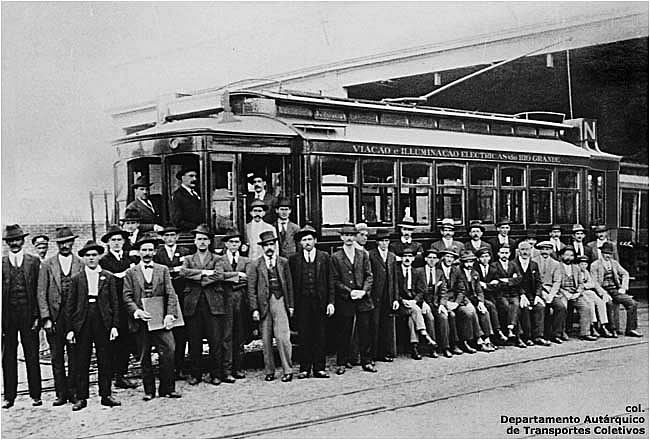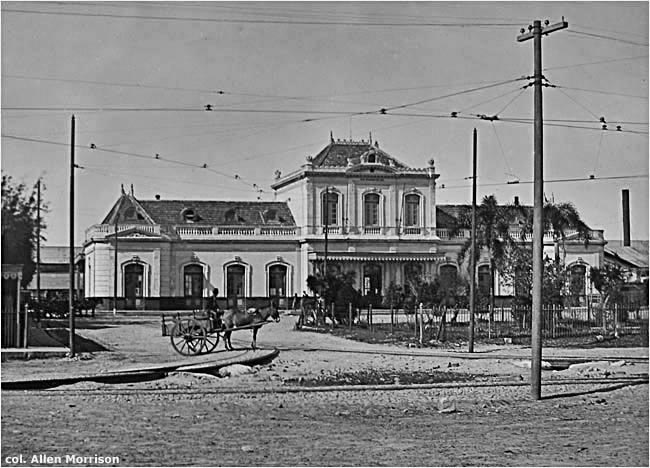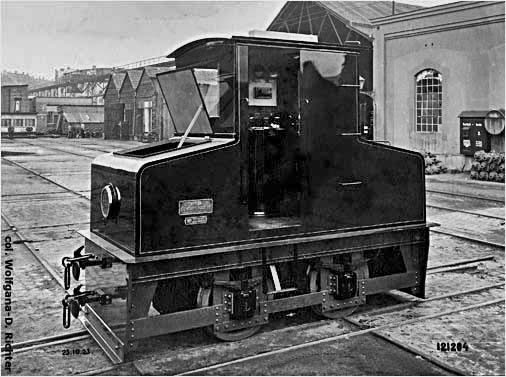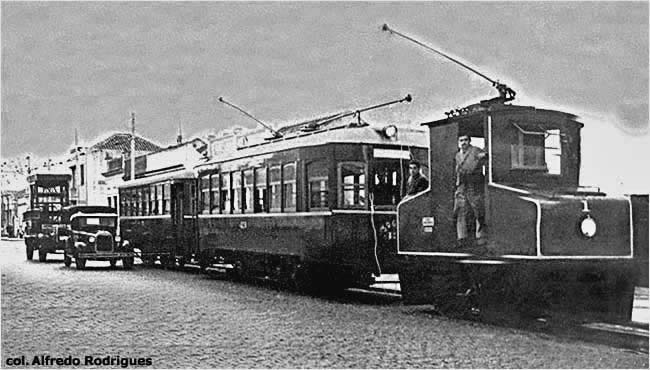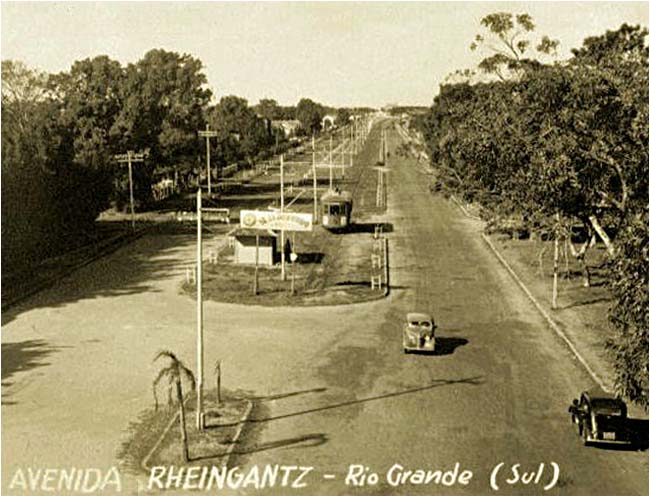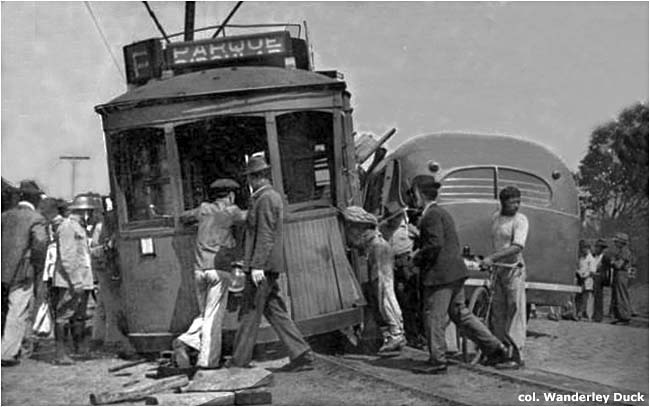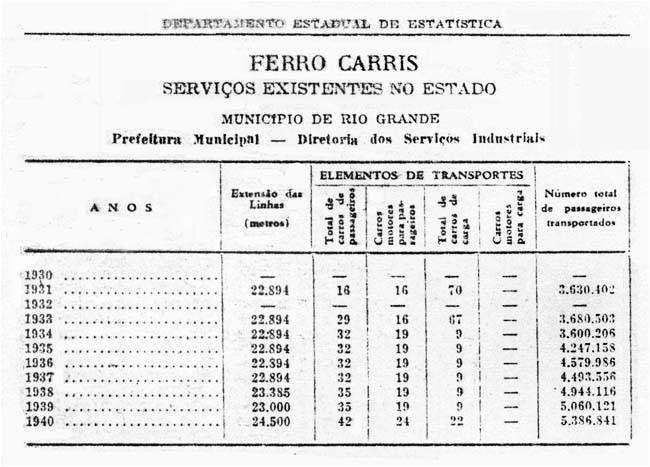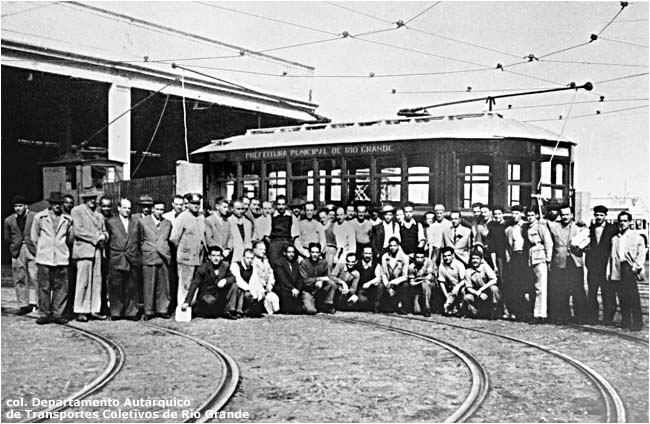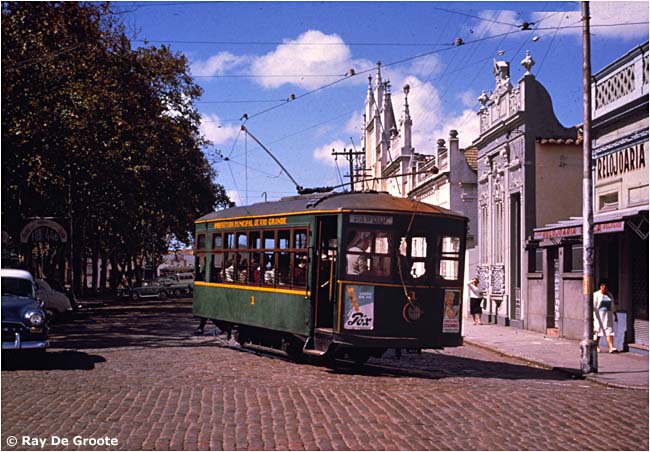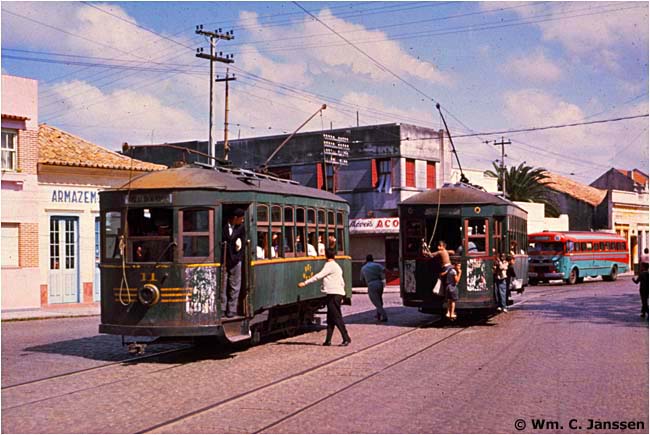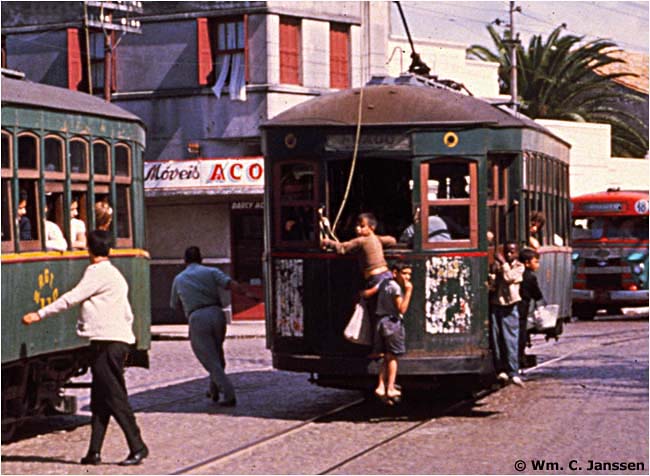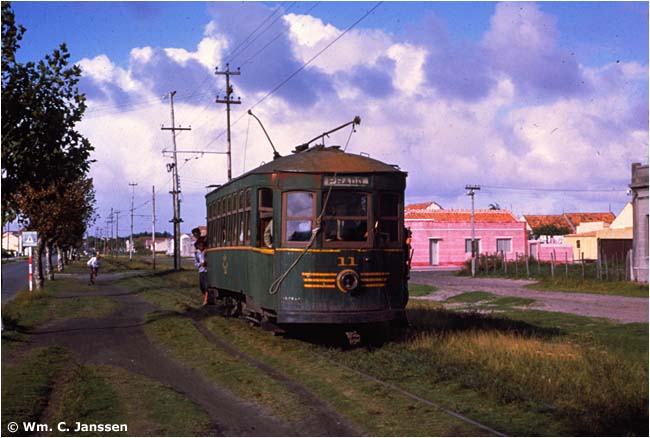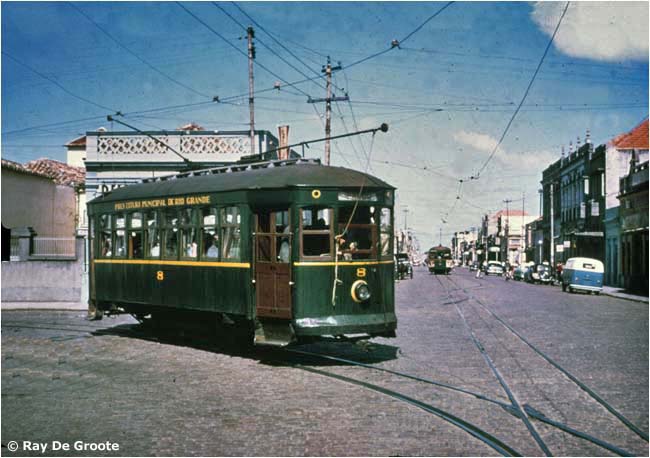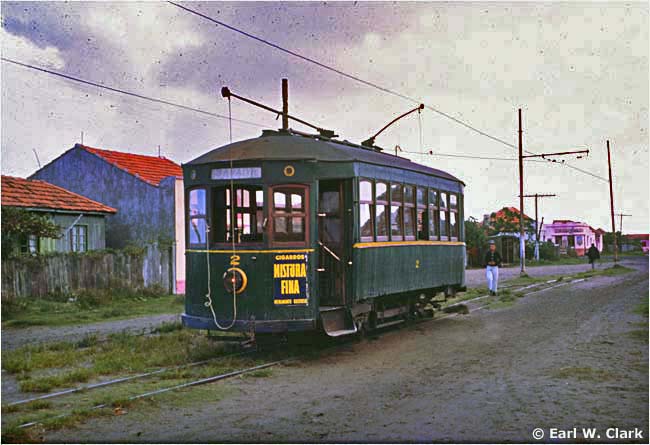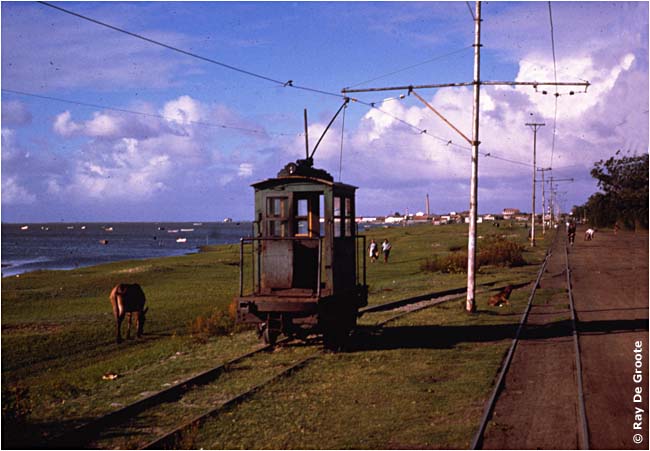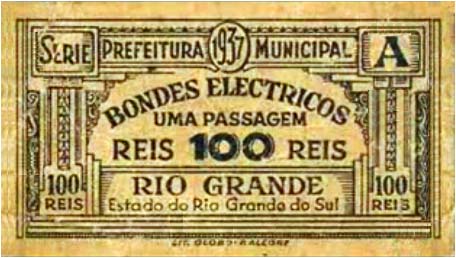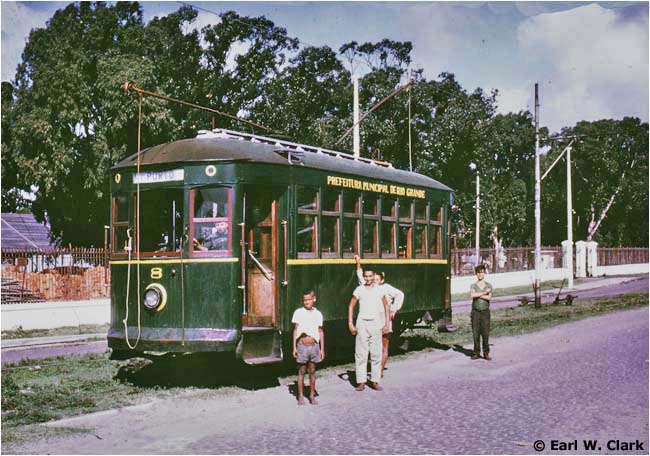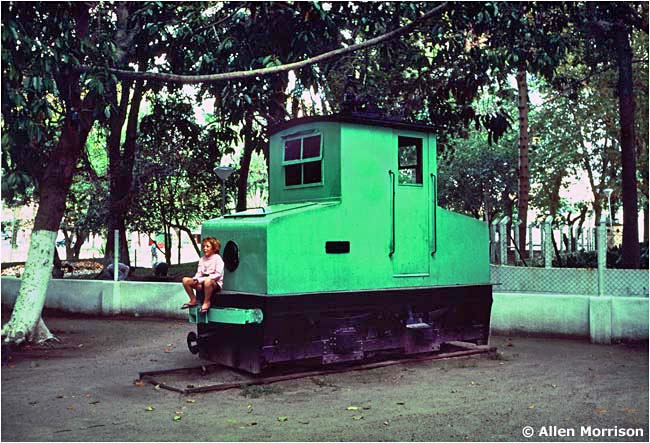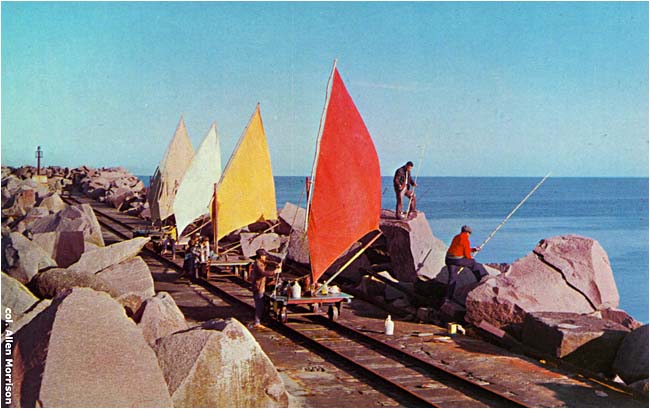The Tramways of RIO GRANDE Rio Grande do Sul state BRAZIL BY Like nearby Pelotas and Porto Alegre, Rio Grande had an urban street railway before it had long-distance trains. A local industrialist named Antônio Cândido Sequeira wanted to develop transportation facilities in the region and founded Companhia de Carris Urbanos do Rio Grande on 23 May 1876. As the steam railroad approached Rio Grande, CCURG inaugurated a mule-drawn tram line from Praça Xavier Ferreira to the new railroad station – the Estação Central – on 2 November 1884 [see city map]. Steam trains began carrying passengers a month later, on 2 December 1884. They went only to Pelotas and Bagé at that time, did not reach Porto Alegre until 1900. The tramway system thrived, and in 1885 Sequeira formed a subsidiary, Companhia de Bonds Suburbanos da Mangueira, to build and operate an 18.6 km "linha de bonds por tração a vapor" (steam-powered tram line) from Rio Grande to a place near the ocean to be called Villa Sequeira [see area map]. He coined the term "bonds suburbanos" (suburban trams) because he did not have permission to operate conventional trains. The scheme failed and he was sued by the Southern Brazilian Rio Grande do Sul Railway, which wanted control of all steam lines in the area [Enke, pp. 52-58: see BIBLIOGRAPHY]. Sequeira finally won permission in 1888, began construction in January 1889 and the following March, through an agent in New York, ordered steam locomotive number 1, named "Andorinha", from H. K. Porter Co. in Pittsburgh. Here is part of the listing in the Porter order books [see complete listing]. "Ca. B. S. M." = Companhia de Bonds Suburbanos da Mangueira. 39 3/8 in = 100 cm [col. Christopher Walker]:
No illustration of that precise locomotive could be found, but according to the description it was the type shown below [col. Christopher Walker]:
CBSM locomotive number 2, named "Formiga", also came from Porter. CBSM acquired passenger cars, began tests in December 1889 and started transporting Brazilians to their first seaside playground on 26 January 1890. (Rio de Janeiro and Santos developed their beaches later.) The steam line began at the end of the Carris Urbanos horsecar line at Parque [see map]. The area around Villa Sequeira station was variously called Costa do Mar or Costa da Mangueira or Casino and is named Cassino (with "ss") today. The line was absorbed by the Southern Brazilian Rio Grande do Sul Railway in 1900 [see Giesbrecht]. The Cassino railway did not go all the way to the beach, so Sequeira built a horse-drawn tramway to take passengers the rest of the way [see Enke text and map. The 0.8 km Cassino tramway seems to have opened along with the railway, in 1890. No one knows how many years it ran, but the photo postcard below shows it in 1913 [col. Antonio Cleber dos Santos Silva]:
Back in Rio Grande, the Companhia Carris Urbanos reorganized itself as Companhia Viação Rio-Grandense, as shown on this ticket [Julio Meili, Das Brasilianische Geldwesen (Zurich, 1903): "Bilhetes de Omnibus, Barcas e Bonds," estampa 126, bilhete 646]:
The postcard below, made about 1905, shows still another owner, Companhia de Bonds Rio-Grandenses. The origin of Rio Grande horsecars is uncertain, but some of the vehicles are said to have been purchased from Porto Alegre, which had trams built by John Stephenson Co. in New York. That is the type car shown in this view, looking east down Rua Gen. Vitorino from Rua 24 de Maio. Praça Tamandaré is out of sight on the left [see map] [col. AM]:
In 1906 the Brazilian government hired American engineer Elmer Corthell to rebuild the Rio Grande port facilities, power plant and tramway system (Corthell had designed ports in New Orleans, Belém and Buenos Aires). Corthell's friend, the American industrialist Percival Farquhar, registered The Port of Rio Grande do Sul, S.A. in Portland, Maine, but could not find adequate investors. Funding for the project was finally secured in France and the firm was reorganized in Paris in 1908 as Compagnie Française du Port de Rio Grande do Sul. American Westinghouse began laying electric tram tracks in Rio Grande in 1910 and ordered fifteen l0-bench passenger motor cars and six l0-bench passenger trailers from J. G. Brill Co. in Philadelphia in 1911. Here is a Brill photograph of trailer car 10 [Brill Collection, Historical Society of Pennsylvania]:
The inauguration date of the electric tramway is often cited as 15 November 1911, but the Porto Alegre newspaper Correio do Povo of 17 November 1912 cites the inauguration a year later, on 15 November 1912 [see BIBLIOGRAPHY, below]. This photograph shows a motor car and trailers bringing workers from the Companhia Swift plant in the southeast corner of the peninsula [see map]. Track gauge of the Rio Grande tramway, as of all railways in the area, was one meter [col. J. J. Abreu]:
On 9 March 1918 the French company was purchased by the state of Rio Grande do Sul and the tramway and other utilities became the property of Viação e Illuminação Eléctricas do Rio Grande. The new company rebuilt many of the open trams as closed models [col. Departamento Autárquico de Transportes Coletivos do Rio Grande]:
|
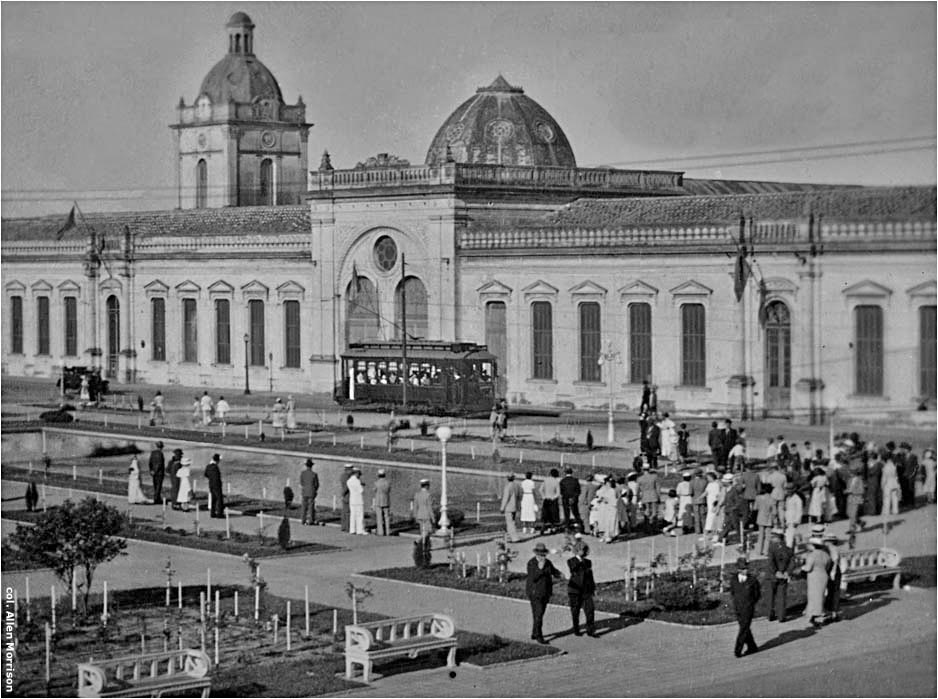
The next postcard shows a tram on Rua Floriano Peixoto on the south side of Praça Xavier Ferreira [see map]. The pool is the same seen in the view above [col. AM]: |
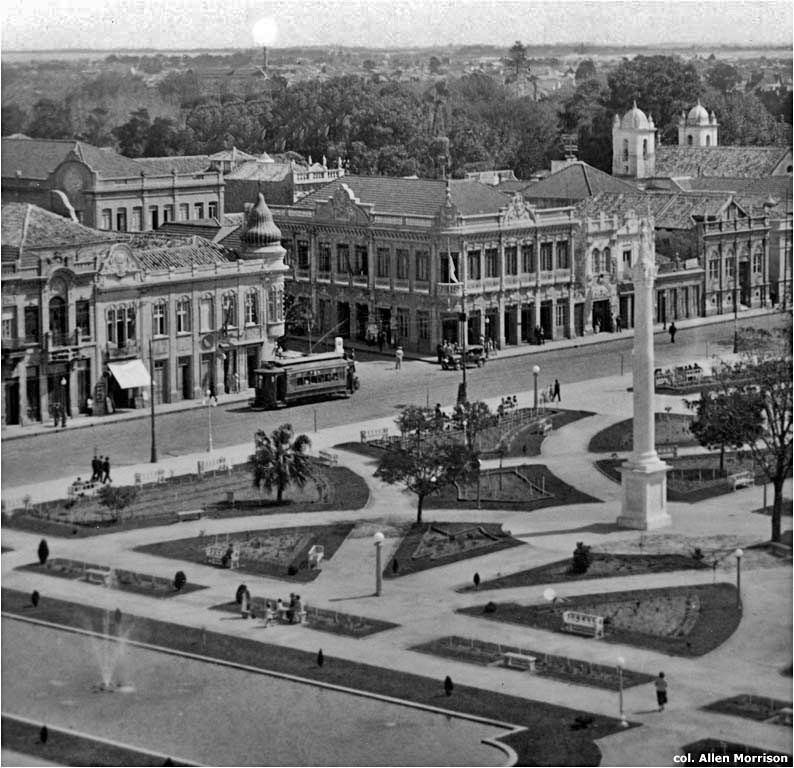
Here is the city's main railroad station, the Estação Central, inaugurated in 1884 (the building is still there today). The view is south from Rua Buarque de Macedo [see map]. Note track and wire of the electric tramway [col. AM]:
|
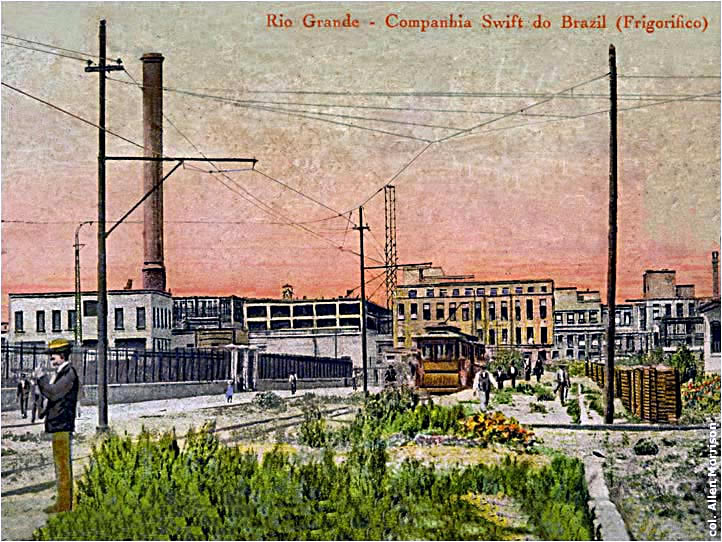
Transporting workers to and from the Swift plant was one of the principal occupations of the tramway company. In 1923, to help pull the trailer trams, it purchased two electric locomotives, numbered 1924 and 1925, from Siemens-Schuckertwerke in Berlin. Assembly was by MAN (Maschinenfabrik Augsburg Nürnberg). Number 1924 in this German picture has both builder's plates [col. Wolfgang-D. Richter]:
This undated photograph shows one of the Siemens/MAN locomotives assisting – pulling? – a motor car and trailer on the "Porto" line [see map]. Both of the passenger cars have had their clerestories removed. The initials "SRGTC" partly visible on electric tram number 43 stood for Serviço Rio Grandino de Transportes Coletivos [col. Alfredo Rodrigues]:
This postcard shows a tram on Av. President Vargas (formerly Av. Rheingantz) at the terminus of the "Parque" line [see map]. View is east. Judging from the automobiles, date is late 1930s. The left (north) lane of the boulevard is blocked, perhaps for repaving, so automobiles are traveling in both directions in the right lane. The "Estação Parque" of the Companhia de Bonds Suburbanos da Mangueira was once at this spot [col. Antonio Cleber dos Santos Silva]:
Even in Rio Grande, a bonde and an ônibus could not occupy the same space at the same time [col. Wanderley Duck]:
The chart below shows track length, number of passenger cars, number of motorized passenger cars (i.e., not trailers) and number of freight cars used by the Rio Grande tramway during the 1930s. (Some data were apparently not reported) [Rio Grando do Sul, Departamento Estadual de Estatística]:
Surveys conducted by the Instituto Brasileiro de Geografia e Estatística in the 1940s revealed similar data – until 1947, when the extensão das linhas in Rio Grande suddenly jumped to 46 km! The company built the new "Saraiva" line during this period, but it was not 21 km long! The extensão remained at 46, number of motor cars at 24 and trailers at 18 – until 1950, when the extensão increased to 47! It stayed there in 1951, when the Instituto published its last detailed tramway report. The photograph below was taken about 1960, after the Serviço Rio Grandino de Transportes Coletivos had been absorbed by the Prefeitura Municipal. By mid-century the clerestories had been removed from all the Brill trams [col. Departamento Autárquico de Transportes Coletivos de Rio Grande]:
In 1940 the tramway company purchased five "Birney" type trams second-hand from United Electric Railways in Providence, Rhode Island. These had been built in 1922 by Osgood Bradley Car Co. in Worcester, Massachusetts and, as with the Birneys that Curitiba acquired from Boston, gauge had to be altered 1435 mm to meter. Here is Birney tram number 1 on the "Parque" line in 1964. It is turning south from Rua Vitorino onto Rua 24 de Maio [see map]. That's Praça Tamandaré on the left. The tram is in the same spot as the horsecar in the fifth illustration at the top of this page [Ray De Groote]:
These color photographs were taken by tramway enthusiasts from North America who visited Rio Grande in the 1950s and 60s. All observed that the Brill cars of 1911 had been rebuilt with new roofs and that there were no longer any trailer trams in service. When the two Brill cars shown below were photographed in 1957, operator was still the Serviço Rio Grandino de Transportes Coletivos. The scene is Rua Aquidaban at Rua General Canabarro. The trams are signed "Saraiva" and "Prado" [Wm. C. Janssen]:
Detail of the previous view [Wm. C. Janssen]:
Here is car 11, again, on the "Prado" line in 1957 [see map]. By the 1950s all the trams had apparently been renumbered. Motor cars such as number 11 may have been built out of former trailers [Wm. C. Janssen]:
Brill tram 8 bore its new Prefeitura livery when photographed at the corner of Ruas Vitorino and 24 de Maio in 1964 [see map]. An ex-Providence "Birney" approaches (departs?) in the distance [Ray De Groote]:
The terminus of the "Saraiva" line in 1963 [see map] [Earl W. Clark]:
One of the tramway's (apparently homemade) locomotives on the "Prado" line in 1964 [see map]. That's the Lagoa dos Patos on the left [Ray De Groote]:
Tram ticket used by the Prefeitura Municipal during the 1960s [col. Antonio Cleber dos Santos Silva]:
Tram 8 on the "Porto" line in 1963 [see map] [Earl W. Clark]:
Number 8, shown above, was the last tram to run in Rio Grande, when the system closed on Thursday 15 June 1967. All the passenger vehicles were scrapped and the depot on Rua Vice Almirante Abreu became the bus garage of the Departamento Autárquico de Transportes Coletivos [see map]. During the author's visit in 1981 there were still tracks in some of the streets and German steeplecab locomotive number 1924 (built in 1923) was displayed on Praça Tamandaré. It is still there today [AM]:
The last steam train ran to Cassino in the early 1960s and the last train left Estação Central for Pelotas and points west in 1990 [see map and Giesbrecht's Estações Ferroviárias do Estado do RS]. The railroad stations at Rio Grande and Cassino (Vila Siqueira) have been preserved. The seaside town is famous today for the world's longest beach, 254 km [see map], acknowledged in the Guinness Book of Records, and the vagonetas a vela (sail-powered cars) that travel along the rails of the molhes da barra, breakwaters, which go 4 km out to sea (see video) [postcard, col. AM]:
BIBLIOGRAPHY United States. Reports from the Consuls of the United States, vol. XXXIV, nos. 120-122 and 133 (9-12/1890). Washington, 1890. A survey of railroads in Rio Grande do Sul contains this paragraph on p. 220: "There is a line of railway just completed from the suburbs of this city to a boating place on the sea-shore by the Companhia Bonds Suburbanos da Mangueira, 18 kilometers in length. This line is well built, is 1 meter in gauge, and the locomotives were furnished by a firm in Pittsburgh, Pa." "Bondes Eléctricos" in Correio do Povo (Porto Alegre), 17/11/1912, p. 7. News item about the inauguration of the electric tramway in Rio Grande in 1912 – not 1911, as is often claimed. Quote: "Rio Grande, 15. Hoje, pela primeira vez trafegou, nesta cidade, um bonde eléctrico, que funcionou regularmente." The newspaper's editions of November 1911 say nothing about tramway inaugurations. Brazil. Instituto Brasileiro de Geografia e Estatística. Anuário Estatístico do Brasil, 1912-1959. RJ, 1917-59. (Issued by Ministério da Agricultura, Indústria e Commércio, 1917; Instituto Nacional de Estatística, 1930-7.) Tramway statistics for Rio Grande and other Brazilian cities. Carvalho, José Carlos de. "A Exploração do Porto da Cidade do Rio Grande." Brazil-Ferro-Carril (Rio de Janeiro), 1/4/1918, p. 168; 30/4/1920, p. 258; 15/5/1920, pp. 291-294. A series of articles about the formation of the French company, the involvement of Corthell and Farquhar, and the construction of Rio Grande tramway. Rio Grande do Sul. Secretaria das Obras Públicas. Direcção Geral do Porto e Barra do Rio Grande. Relatório Annual, 1923. Porto Alegre, 1923. "Galpão dos bondes" section on pp. 168-171 includes tram roster. Rio Grande. Prefeitura Municipal. Directoria dos Serviços Industriaes. Planta Geral da Cidade do Rio Grande. RJ, 1937. Street map, scale 1:10,000, shows track layout of the electric tramway. Waldemar Corrêa Stiel. História do Transporte Urbano no Brasil. Brasília, 1984. The chapter on Rio Grande, pp. 307-311, contains some interesting photographs and reproductions of tramway itineraries from undated editions of the Almanak do Rio Grande do Sul. Rebecca Guimarães Enke. Balneário Villa Sequeira: A invenção de um novo lazer (1890-1905). PDF of 143-page dissertation at Universidade do Vale do Rio dos Sinos, São Leopoldo (RS), 2005. Construction of the "Bonds Suburbanos" line, pp. 52-58. Cassino tramway, pp. 86 and 91. Ralph Mennucci Giesbrecht. Estações Ferroviárias do Brasil. Extraordinary survey of Brazil's railroad stations and lines. The section on the Rio Grande area contains rare, fascinating information on the Cassino line and the stations along it. Links to many photographs. Luiz Henrique Torres. "O Cassino entrando na história" and "O surgimento do balneário Cassino" in Agora: O Jornal do Sul (Rio Grande). Two of several interesting articles by this professor, published in this online journal. Use "Busca" mechanism to find other articles, Antonio Cleber dos Santos Silva. Breve Histórico do Transporte na Cidade do Rio Grande/RS. Texts and many interesting photographs in an 18:40-minute video showing Rio Grande's transport history.
The author would like to thank Christopher Walker in England, Wolfgang-D. Richter in Germany, Ralph Mennucci Giesbrecht, Antonio Cleber dos Santos Silva and Guilherme Guimarães in Brazil, and the staff of the Departamento Autárquico de Transportes Coletivos in Rio Grande for their contributions and assistance in the preparation of this page.
Also see The Tramways of Pelotas And my index of If you have comments, criticism or suggestions, This site was placed online on Copyright © 2009-2109 Allen Morrison As fotos coloridas desta página são protegidas pela Lei do Direito Autoral (Lei N° 9.610 de 19 de Fevereiro de 1998) e não podem ser reproduzidas sem a expressa autorização do autor. |
